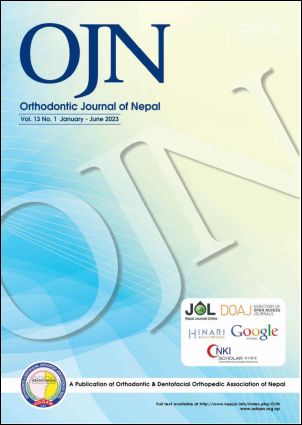Effects of thalassaemia major on components of the craniofacial complex- a cephalometric study in Andhra Pradesh population
DOI:
https://doi.org/10.3126/ojn.v13i1.52672Keywords:
Anaemia, craniofacial growth, cephalometry, thalassaemia majorAbstract
Introduction: The cephalometric study was conducted to evaluate the craniofacial effects of thalassaemia major on the Andhra Pradesh population.
Methods: A total of 32 thalassaemic patients (23 male, 9 female) were selected from the Thalassaemia and Sickle Cell Society and 32 controls (19 male, 13 female) from schools of Hyderabad city to eliminate any bias on the ethnic background. All 64 lateral cephalograms were taken under standard conditions with teeth in occlusion and lips in a relaxed position. Forty - two linear and angular cephalometric parameters defining craniofacial morphology (22 skeletal, 13 dentoalveolarand 7 softtissue) were selected.
Results: Everypatient with thalassaemia exhibited a skeletal base relationship of class II, accompanied by an average ANB angle of 4°. There was a significant increase in the length of the anterior cranial base. The length of the maxillary and mandibular base was significantly reduced, and the mandible appeared to be retruded in the face. Pronounced vertical growth was evident from linear and angular measurements. The dental deviations seen in thalassaemic patients were proclination, significant over-eruption of the maxillary anterior teeth and increased overjet. A marked increase in the convexity of the lower face, prominent upper lip, reduced nasolabial angle and increased inter-labial angle were evident from soft tissue measurements.
Conclusions: The reduced length of the maxillary and mandibular base could be due to chronic anaemia which causes retardation of growth in thalassaemic patients. An increase in the anterior cranial base length resulted in the posterior positioning of the mandible and an increase in anterior facial height led to a skeletal class II pattern.
Keywords: Anaemia; craniofacial growth; cephalometry; thalassaemia major.
Downloads
Downloads
Published
How to Cite
Issue
Section
License
Copyright (c) 2023 Orthodontic & Dentofacial Orthopedic Association of Nepal

This work is licensed under a Creative Commons Attribution 4.0 International License.
Copyright © held by Orthodontic & Dentofacial Orthopedic Association of Nepal
- Copyright on any research article is transferred in full to the Orthodontic & Dentofacial Orthopedic Association of Nepal upon publication in the journal. The copyright transfer includes the right to reproduce and distribute the article in any form of reproduction (printing, electronic media or any other form).
- Articles in the Orthodontic Journal of Nepal are Open Access articles published under the Creative Commons CC BY License (https://creativecommons.org/licenses/by/4.0/)
- This license permits use, distribution and reproduction in any medium, provided the original work is properly cited.




